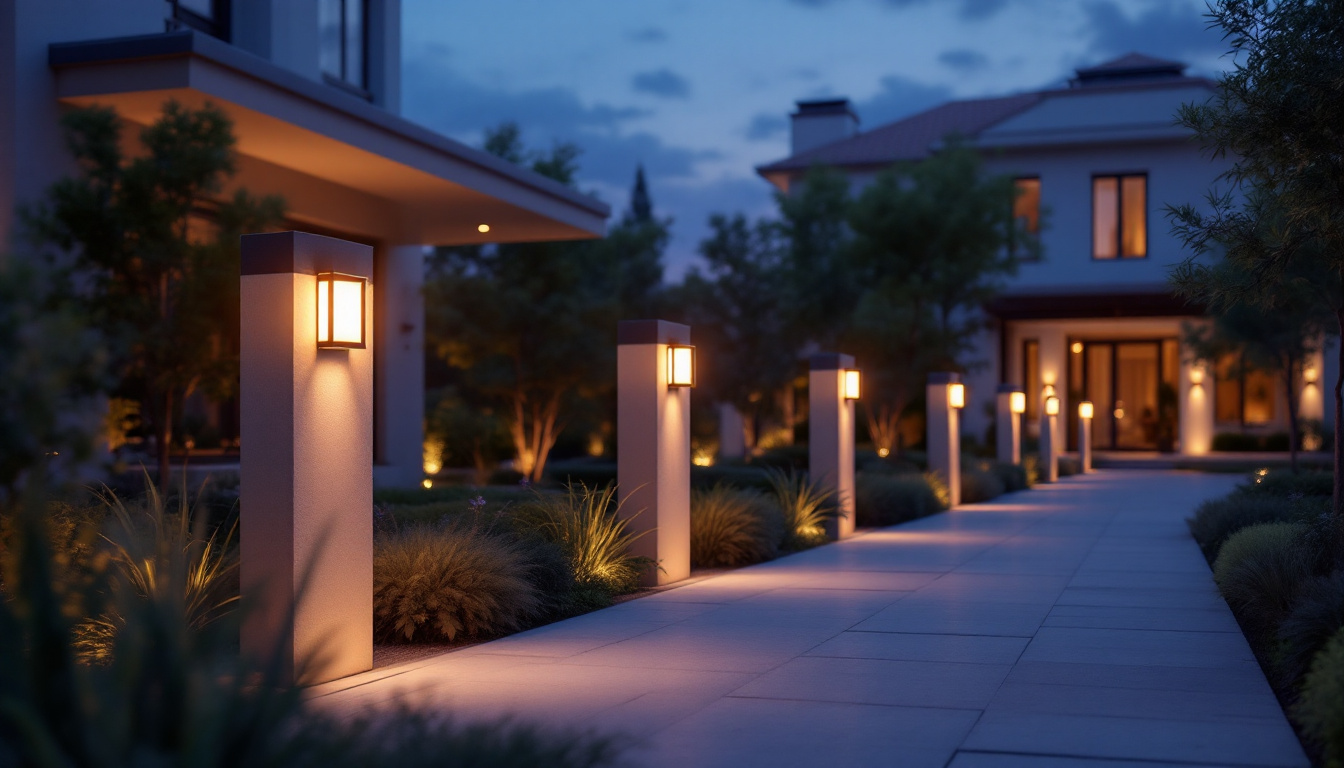
In the realm of outdoor illumination, exterior post lighting plays a pivotal role in enhancing safety, aesthetics, and functionality. For lighting contractors, understanding the best practices surrounding the installation and maintenance of these fixtures is essential. This article delves into the key considerations, techniques, and recommendations that can elevate the quality of exterior post lighting projects.
Exterior post lighting serves multiple purposes, from illuminating pathways and driveways to accentuating landscaping features. It not only enhances visibility but also contributes to the overall ambiance of outdoor spaces. For contractors, recognizing the significance of these fixtures is the first step toward delivering exceptional service to clients.
One of the primary functions of exterior post lighting is to ensure safety. Well-lit areas deter potential intruders and reduce the risk of accidents. Lighting contractors should emphasize the importance of strategic placement to illuminate dark corners, pathways, and entry points effectively. This not only protects property but also provides peace of mind for homeowners. Additionally, exterior post lighting can be equipped with motion sensors, further enhancing security by automatically illuminating when movement is detected. This feature not only conserves energy but also adds an extra layer of protection, making it a wise investment for any homeowner concerned about safety.
Beyond safety, exterior post lighting enhances the visual appeal of a property. By selecting the right fixtures and positioning them thoughtfully, contractors can create inviting outdoor spaces. The interplay of light and shadow can highlight architectural features, gardens, and walkways, transforming a mundane exterior into a captivating environment. Furthermore, the choice of lighting style—whether modern, rustic, or traditional—allows homeowners to express their personal taste and elevate the overall design of their property. Incorporating dimmable options can also provide versatility, allowing for a softer glow during intimate gatherings or a brighter setting for larger events, thus making the outdoor area functional for various occasions.
When it comes to exterior post lighting, the selection of fixtures is paramount. Contractors must consider various factors, including design, material, and functionality, to ensure that the chosen lighting complements the overall aesthetics of the property.
The design of post lighting fixtures should align with the architectural style of the home and landscape. For instance, modern homes may benefit from sleek, minimalist designs, while traditional properties might call for ornate fixtures. Understanding the client’s vision and the surrounding environment will guide contractors in making informed choices. Additionally, the scale of the fixtures is crucial; oversized fixtures can overwhelm a small space, while diminutive lights may get lost in a grand landscape. Therefore, a careful balance must be struck to enhance the visual appeal without compromising functionality.
Exterior lighting fixtures are exposed to the elements, making durability a critical factor. Materials such as stainless steel, aluminum, and high-quality plastics are often preferred for their resistance to rust and corrosion. Contractors should educate clients on the importance of investing in durable fixtures that will withstand harsh weather conditions, ensuring longevity and reduced maintenance costs. Furthermore, the choice of finish can also impact durability; powder-coated finishes, for example, not only provide a sleek look but also offer additional protection against fading and scratching. It’s essential to consider the local climate when selecting materials, as regions with extreme temperatures or humidity may require specialized fixtures designed to endure those conditions.
Proper installation is crucial for the performance and longevity of exterior post lighting. Lighting contractors must adhere to best practices to ensure that fixtures operate efficiently and safely.
Before installation, a thorough site assessment is essential. Contractors should evaluate the landscape, existing structures, and potential obstacles that may affect lighting placement. This assessment allows for strategic positioning of fixtures to maximize illumination while minimizing glare and light pollution. Additionally, understanding the natural light patterns throughout the day can help in determining the best locations for the fixtures. For instance, areas that receive ample sunlight during the day might benefit from solar-powered lights, while shaded regions may require wired fixtures for consistent performance.
Electrical safety is paramount when installing exterior lighting. Contractors must adhere to local codes and regulations, ensuring that all wiring is properly insulated and protected from moisture. Utilizing weatherproof connectors and junction boxes can prevent electrical failures and hazards. Additionally, considering the use of low-voltage systems can enhance safety and reduce energy consumption. It’s also advisable to incorporate timers or smart controls that allow for automated operation, which can further optimize energy efficiency and provide convenience for homeowners. Moreover, ensuring that all components are rated for outdoor use is essential to withstand the elements and prolong the lifespan of the installation.
The height and placement of post lights significantly impact their effectiveness. Generally, post lights should be installed at a height that allows for optimal illumination without creating excessive glare. A common recommendation is to position fixtures between 12 to 18 inches above the ground. Contractors should also consider the spacing between fixtures to ensure even lighting coverage across the area. Furthermore, the aesthetic appeal of the lighting should not be overlooked; the design and style of the fixtures can enhance the overall landscape while providing functional illumination. For instance, aligning post lights along pathways or driveways can create a welcoming ambiance, guiding visitors safely while accentuating the beauty of the surroundings. Careful consideration of these factors can transform a simple lighting installation into a visually striking feature of the property.
In today’s environmentally conscious landscape, energy efficiency is a key consideration for lighting contractors. By integrating sustainable practices and energy-efficient technologies, contractors can provide clients with solutions that reduce environmental impact while saving on energy costs.
LED lighting has revolutionized the exterior lighting industry. These fixtures consume significantly less energy than traditional incandescent or halogen bulbs, leading to lower utility bills. Additionally, LEDs have a longer lifespan, reducing the frequency of replacements. Contractors should encourage clients to consider LED options for their exterior post lighting to promote sustainability and efficiency.
Smart lighting technology offers enhanced control and flexibility for outdoor lighting systems. Contractors can recommend systems that allow homeowners to adjust brightness, set schedules, and even control lighting remotely via smartphone apps. This not only enhances convenience but also contributes to energy savings by allowing users to turn off lights when not needed.
Regular maintenance is essential to ensure the longevity and performance of exterior post lighting. Contractors should provide clients with guidelines on how to care for their fixtures and what to look out for in terms of potential issues.
Dust, dirt, and debris can accumulate on fixtures, diminishing their effectiveness. Contractors should advise clients to clean their post lights regularly, especially in areas with heavy foliage or dust. Additionally, periodic inspections can help identify any signs of wear or damage, allowing for timely repairs before issues escalate.
For fixtures that use traditional bulbs, contractors should inform clients about the importance of timely bulb replacement. Dimming or flickering lights can indicate that a bulb is nearing the end of its lifespan. Educating clients on the signs of bulb failure can help maintain consistent illumination and prevent unexpected outages.
Exterior post lighting can be further enhanced by incorporating landscape elements into the design. By integrating lighting with landscaping features, contractors can create a cohesive outdoor environment that is both functional and visually appealing.
Strategically placing post lights along pathways and garden borders can guide visitors safely while showcasing the beauty of the landscape. Contractors should consider using fixtures that complement the surrounding flora and fauna, creating a harmonious blend of light and nature.
Post lighting can also be utilized to create focal points within the landscape. By illuminating specific trees, sculptures, or architectural features, contractors can draw attention to these elements and enhance the overall aesthetic of the outdoor space. This technique adds depth and dimension, making the landscape more engaging.
Effective communication with clients is vital for successful exterior post lighting projects. Lighting contractors should prioritize educating clients about their options, the installation process, and maintenance requirements.
During the initial consultation, contractors should take the time to understand the client’s vision and preferences. This collaborative approach ensures that the final design aligns with the homeowner’s expectations. Providing visual aids, such as sketches or digital renderings, can help clients visualize the proposed lighting layout.
After the installation is complete, a follow-up visit can reinforce the contractor’s commitment to customer satisfaction. This allows contractors to address any questions or concerns the client may have and ensure that the lighting system is functioning as intended. A proactive approach can lead to positive word-of-mouth referrals and repeat business.
Exterior post lighting is a vital component of outdoor design, offering safety, aesthetic appeal, and functionality. By adhering to best practices in fixture selection, installation, energy efficiency, and maintenance, lighting contractors can deliver exceptional results that meet the needs of their clients. Educating clients and fostering open communication throughout the process enhances the overall experience and builds lasting relationships. As the demand for outdoor lighting solutions continues to grow, contractors who prioritize these best practices will undoubtedly stand out in a competitive market.
Ready to elevate your exterior post lighting projects with the finest selection of spec-grade lighting products? Look no further than LumenWholesale. Our commitment to quality, affordability, and convenience ensures that you have access to the best lighting solutions at wholesale prices. With free shipping on bulk orders, you can trust that you’re getting premium lighting without any hidden fees. Enhance the safety, beauty, and functionality of your outdoor spaces today. Visit LumenWholesale for Wholesale Lighting at the Best Value and make your next lighting project shine.

Discover effective strategies for lighting contractors to tackle common challenges with LED strip lighting tape.

Discover why fluorescent fixtures remain a staple for lighting contractors in this insightful article.

Discover how vintage LED lights can transform your lighting projects with their perfect blend of classic charm and modern efficiency.

Discover overlooked tips on discount chandelier lighting that lighting contractors often miss.